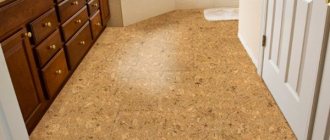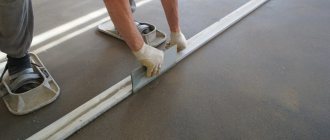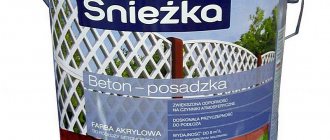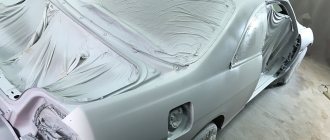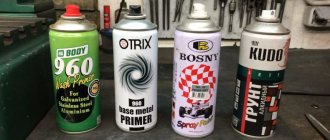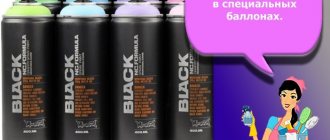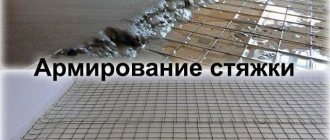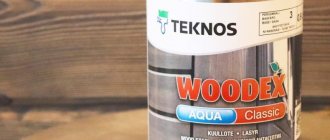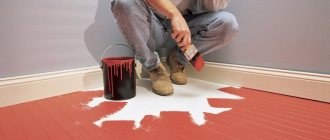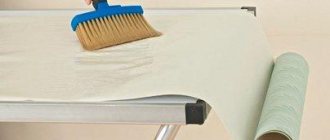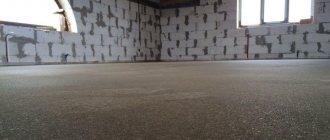Icer
12635 0 3
Icer November 1, 2016Specialization: master in the construction of plasterboard structures, finishing work and laying floor coverings. Installation of door and window units, finishing of facades, installation of electrical, plumbing and heating - I can give detailed advice on all types of work.
To lay the flooring, the base must be properly prepared.
Some developers think that priming for floor screed is an extra step in the work process. They say, the surface is already very strong, why strengthen it additionally. In fact, everything is not so - the composition must be applied; if you do not do this, you will subsequently encounter a number of problems that can even lead to the dismantling of the floor covering .
This is what can happen if you don't prepare the floor
Properties and functions of primer for floor screed
The use of a primer is considered a mandatory step when using cement or sand screed. This also applies to cellular concrete. The use of a special substance helps to obtain the following results:
- bind dust and dirt;
- strengthen the coating;
- reduce the absorption characteristics of the coating;
- achieve a high degree of adhesion;
- get an antiseptic effect.
Any material that is applied to the ground will not dry quickly. This means that it will be quite strong and hard. If repair work is carried out incorrectly, there is a risk of air bubbles appearing or the material becoming saturated with excess moisture. That’s why soil is applied to the floor. It helps prevent these problems from occurring.
Conclusion
Priming the screed and the base underneath is an important part of the work, which ensures maximum reliability of the floor and prevents dust formation. The video in this article will help you understand the topic even better, and if you have questions or encountered unexpected difficulties while performing the work, then write in the comments under the review, we will sort out all the nuances together.
Did you like the article? Subscribe to our Yandex.Zen channel
November 1, 2016
Pouring and screeding floors, Construction Chemicals
If you want to express gratitude, add a clarification or objection, or ask the author something, add a comment or say thank you!
Pros and cons of applying a primer coat
The use of primers has the following advantages:
- increasing the degree of adhesion, which provides excellent adhesion to subsequent coatings through mutual penetration of layers;
- compaction of the loose structure by filling pores and voids;
- dust removal;
- reduction of water permeability;
- protection from moisture, the formation of mold and fungi - this is especially important in rooms with high humidity.
At the same time, the use of soil is practically free of disadvantages. However, to obtain the desired results, it is important to choose the right composition and strictly follow the rules for its application.
What primer is suitable for screed
It is permissible to use different types of soil under the screed. They differ in composition and characteristics.
Polyurethane
This primer is classified as a deep penetration compound. The mixture contains solvents and dyes. The substance is used before pouring self-leveling material. It can also be applied to concrete floors. Often, polyurethane primer is applied after the screed - before using enamel.
This impregnation helps achieve the following results:
- prevent the accumulation of large numbers of bacterial microorganisms and mold formation;
- strengthen the surface;
- protect the coating from moisture getting inside;
- reduce dye consumption.
The composition of the soil includes binding particles of microscopic size, which ensures deep penetration of particles into concrete and clogging of pores. Such substances essentially glue the upper structures of the floor together.
Polyurethane primer normally withstands the effects of aggressive chemical elements and can withstand any load. Therefore, the material is often used for floors in industrial premises.
See also
6 suitable types of paint for a concrete fence and step-by-step application
Epoxy
When carrying out repair work in a room with high humidity, the floor surface requires special protection. Two-component epoxy substances are perfect for this.
They are highly reliable, penetrate deep into the structure of the material and protect the surface well from moisture. The main disadvantage of the material is its high cost.
Strengthening
This soil is a low-viscosity polymer composition that is distributed over the surface of freshly laid or hardened concrete. The substance helps reduce dust separation, increase the strength of the coating and improve its water-repellent characteristics.
Popularly, these types of soil are often called deep penetration substances. After drying, the substance polymerizes. Thanks to this, it provides additional tightening of the base material.
Concrete contact
This composition is an adhesive primer. However, it is essentially glue. The substance is made from acrylic and quartz sand. The second component gives the smooth base a rough structure. The material has many advantages. These include the following:
- fast drying rate - literally after 2 hours you can begin the next stage of work;
- long period of operation - according to the manufacturer, the coating can be used for 80 years;
- reliable protection against moisture - after drying, the primer forms a film that successfully performs waterproofing functions.
Other
It is permissible to use other types of compounds for priming floor coverings. The most popular substances include:
- Mineral - may contain glue, cement, antiseptic components. Also, the composition often contains film-forming, water-repellent, and adsorbent substances. This soil can be used for concrete foundations. It dries quickly and is considered completely safe. At the same time, the composition can hardly withstand the influence of aggressive substances.
- Liquid glass - helps make concrete more resistant to moisture. The composition includes sand, silicates, soda. The primer should be applied to the concrete floor, which helps create a flawless surface with water-resistant properties. The substance sets quickly, but does not last long.
- Glypthal primer - usually used for treating metal surfaces. Thanks to this, the base becomes stronger. The material is suitable for interior work. The coating takes 24 hours to dry.
- Perchlorovinyl composition - used for brick and plastered surfaces for outdoor work. The substance can also be used to treat concrete surfaces that are located outdoors. It only takes 1 hour for the soil to dry.
- Polyvinyl acetate primer - used when polyvinyl acetate paint is required to be applied to the surface. The composition is suitable for different types of floors. It takes no more than a quarter of an hour to dry. With the help of such a primer it is possible to reduce the need for paints and varnishes for subsequent processing.
How to paint concrete after priming
Paints intended for use on concrete differ in their protective, operational characteristics, and application features.
Epoxy paints
It is recommended to use epoxy primers for such materials. The paint itself is a two-component composition that requires mixing immediately before application. This is a good solution for interior work, especially for painting floors. This is due to its high chemical resistance, wear resistance, and water resistance.
Acrylic
Application is carried out over acrylic and acrylate primers. The material works well indoors, providing resistance to high humidity and temperature changes. This is facilitated by high decorative characteristics, a variety of textures and colors.
Polyurethane paints
The composition provides high resistance to chemical attack and other operational loads. In practice, application is carried out on concrete coated with polyurethane primers (one- or two-component). The main purpose is to cover floors. Like acrylic compositions, a nice appearance is ensured.
Rubber
This wear-resistant paint is renowned for its resilience. A film based on such material can be bent and rolled without breaking its integrity. These properties work well under mechanical loads, which is why the material is used to cover indoor floors. It is better to apply rubber paint over an acrylic primer.
Urethane-alkyd
The material demonstrates high hiding power and high abrasion resistance. The finished surface is glossy, but you can expect a wide variety of colors. The paint adheres well to alkyd primers.
Recommendations for selection
To select a high-quality primer, you need to take into account many features - type of surface, composition, degree of exposure, release form.
On the treated surface
All types of soil are divided into 2 large categories:
- universal - can be used indoors and outdoors;
- highly specialized - intended only for interior or exterior work.
See also
Types of ultraviolet curing paints and brand ratings, how to apply
So, acrylic solution is suitable for rooms with high humidity. High-quality material should contain components that will help avoid the formation of mold and mildew. For the same reason, before screeding, it is worth treating the floor in basements and other rooms that do not receive sunlight.
If there are large defects or delaminations on the concrete surface, you should choose a deep penetration primer. Otherwise, there is a risk that the screed will not work.
Expert opinion
Zakharova Irina Yurievna
Cleaning professional with 15 years of experience. Our best expert.
Ask a Question
If you want to protect the surface from moisture and obtain a non-conductive coating, it is better to give preference to polystyrene concentrate.
Phenolic primer is suitable for treating wooden surfaces. However, it is important to consider that the material can cause poisoning. Therefore, during work it is very important to use protective equipment and systematically ventilate the room.
By composition and degree of impact
Depending on the composition, the following types of primers are distinguished:
- Epoxy - a special solvent is required to dilute it. The surface treated with this type of soil obtains excellent moisture-proof characteristics. It is used for arranging floors in the bathroom, swimming pool or toilet. It is permissible to apply the composition to a slightly moistened surface.
- Acrylic - considered the most popular material. It can be applied to different types of surfaces - brick, concrete, wood. The solution is considered completely safe. There are different forms of release on sale - concentrated and ready-made formulations. It is permissible to use ordinary water as a diluent. It takes no more than 4 hours to dry. Acrylic primer is not suitable for processing dark iron.
- Alkyd - most often used for application to wood. The soil loosens its surface. Due to this, the concrete screed adheres well to the wood. It does not crack or delaminate. It takes 10-12 hours for the primer to dry. After this treatment, the wood is not susceptible to fungi, mold, or rotting. The base of the substance is zinc phosphate or chromate.
- Perchlorovinyl - is a specialized primer that is suitable for concrete, brick and metal surfaces. The substance contains toxic components, so it can only be used for external use. A special line has been created for metal coatings that quickly stops the corrosion process. It takes 1 day to dry.
- Polystyrene - most often used for wood processing. Since the composition contains toxic ingredients, the substance should be used for outdoor use.
- Polyvinyl acetate - the composition includes latex and polyvinyl acetate dispersion. The material is suitable for application to brick, stone, and plasterboard bases. After applying the primer, it is possible to obtain a resistant film that takes only 15-30 minutes to dry.
- Glyphthalic - the base includes alkyd varnish mixed with stabilizers. The composition can be used indoors for application to metal. However, it takes 24 hours to dry.
Depending on the degree of impact, the following types of soil are distinguished:
- Superficial penetration – suitable for durable substrates that do not require strengthening from the inside. The material penetrates into the floor structure by 2-3 millimeters.
- Deep penetration - used for weakened and loose structures that need to be strengthened from the inside.
See also
Technical characteristics and composition of VL-02 primer, rules of application
By release form
According to the form of release, the following types of soil are distinguished:
- concentrated - they need to be diluted;
- Ready to use - just shake them and apply to the surface.
Why is soil treatment important?
Concrete flooring has always been considered the most durable. For a long time, this type of coating was used as widely as possible. Its affordable price also spoke in favor of his choice.
Despite all its positive qualities, concrete has significant disadvantages. It is hygroscopic, and moisture absorbed into the surface at sub-zero temperatures gradually destroys the surface.
This often leads to the formation of mold and mildew. Concrete is not resistant to abrasion and cannot withstand impact loads. Deep penetration primers increase the strength of the surface and extend its service life.
Concrete floors are now not often used as a stand-alone covering. It usually serves as a base for other materials. The most popular option is a polymer self-leveling floor.
For it to meet the specified parameters, good adhesion of the base and finishing coating is necessary. The primer composition performs this function.
Rating of the best brands
The most popular brands that produce high-quality primers include:
- “Prospectors” - the composition is capable of filling microscopic pores and cracks. It contains quartz sand, which significantly increases the adhesion characteristics of the base to the finishing material. The composition can be used for external and internal work.
- "Ceresit" - the company has been known on the market for about 100 years. It produces sought-after high-quality products. Primers have a water-dispersion base. They use synthetic resins as the main component.
- "Optimist" - the manufacturer offers primers for exterior and interior use. They are produced in the form of solutions of fine latex with the addition of quartz sand, antiseptic components, and modifying additives. The composition can be used for application to coatings in rooms with high humidity. It has leveling properties and increases the degree of adhesion.
- "Tex" is a universal product that can penetrate porous surfaces to a depth of 6 millimeters. Due to its good absorbent properties, the primer can be used for external and internal work.
Surface preparation
Before work, you should check whether the fur coat is falling off the roller. If lint or fibers remain in the solution and fall onto the floor, they will be difficult to remove later. We check the quality of the fur coat like this: first we try to pull the pile with our fingers. Then, to be sure, we prime a small test area with a roller, wait for it to dry and see if the fur coat has left fibers and lint on its surface. It would be a good idea to repeat the check. If everything is in order, you can start working.
The floor surface must also be prepared for priming:
- remove the old coating (manually, with a grinding machine), peeling on the screed;
- we clean from dust, dirt, oil stains, grease and wipe off with a solvent;
- We sand the wooden floor with sandpaper along the grain, first coarse-grained, then fine. It is better to wrap the skin on a wooden block and secure it with a stapler - it is more convenient to work;
- knots on pine boards often release resin - we clean them off with a spatula. Performing again? We heat the knot with a hairdryer and cover it with shellac primer;
- vacuum and thoroughly wash the floor surface. Waiting for it to dry.
Why so much pre-work? Before applying the mixture, the surface must be perfectly clean. Dust, pieces of dirt and small “construction” rock, oil stains, resin, and peelings violate the tightness of the primer layer. This means that the strength of the base for the finishing layer is not guaranteed.
Have you ignored the condition of cleanliness? Expect mold at the seams, cracks, and chips on the tile sheets in a couple of months.
How to properly prime under a screed
In order for the application of a primer under the screed to be effective, it is important to strictly adhere to the rules of the work.
Soil consumption and solution preparation features
Material costs vary - it all depends on the composition of the primer, the condition of the floor, and the number of layers. On average, primer consumption is 200-350 grams per 1 square meter of area. However, the approximate material consumption is indicated on the packaging.
Required Tools
To facilitate the priming process, you need to buy a special container - a paint bath. It is permissible to apply the material with a roller or an ordinary brush. It is also worth preparing personal protective equipment.
Concrete floor preparation
To prepare the surface, do the following:
- Clean the floor from dust, dirt, oil and other stains.
- Remove sagging solution and loose particles.
- Seal the cracks.
Priming technique
The soil must be diluted to the condition recommended by the manufacturer. The composition can be applied with a roller or brush. It is important to monitor the temperature and humidity of the coating.
Layer drying time
The drying time is affected by the composition and characteristics of the surface. On average, this takes 4-12 hours.
Further work
Subsequent work depends on the purpose of the room. After applying the primer, you can proceed to finishing with paints or tiles.
Specifications table
| Characteristics | Unit measurements | Meaning |
| Soil consumption | g/m2 | 50-300 |
| pH | 7,0-8,5 | |
| Penetration depth | mm | 5-10 |
| Drying time | h | 2-6 |
| Application temperature | °C | +5/+35 |
| Operating temperature | °C | -40/+60 |
| Maximum particle size | µm | 0,05 |
